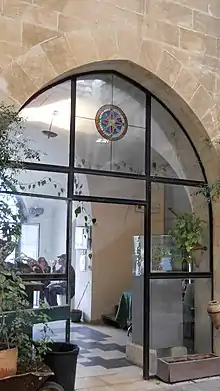Albert Clifford Holliday | |
|---|---|
| Born | 21 December 1897 Gildersome, England |
| Died | 26 September 1960 (aged 62) Manchester, England |
| Nationality | British |
| Alma mater | University of Liverpool |
| Occupation | Architect |
| Design | Master plan of Jerusalem |

Albert Clifford Holliday (1897–1960) M. Arch, Dip. C.D., F.R.I.B.A., M.T.P.,[1] was a British architect and town planner who worked in several places across the British Empire, including Mandatory Palestine, Ceylon and Gibraltar, as well as in the UK.
Studies
Holliday gained his qualifications at the University of Liverpool where he studied under Sir Charles Reilly and Patrick Abercrombie.[2] He later designed the University of Ceylon with Abercrombie.[3]
Career
Mandate Palestine
Holliday was commissioned as civic adviser to the city of Jerusalem between 1922 and 1926[3] and town planning advisor to the mandatory government of Palestine between 1928 and 1934.[2] He drew up a master plan for Jerusalem and the restoration of its Old City walls.[4]
United Kingdom
In 1938, Holliday's design for a satellite town near Kincorth, outside Aberdeen, won an international prize.[3]
In 1947, he was appointed Chief Architect for the first postwar British new town, Stevenage.[2] He revised the plan for Stevenage, from the Ministry of Town and Country Planning's original plan, in 1949.[5]
In 1952 Holliday became Professor of Town and Country Planning at the University of Manchester.[3]
He was also involved in preparing the designs for Haslingden and Stoke-on-Trent.[3]
Private life
Holliday had four sons.
Selected work
Buildings
Jerusalem
- St John Ophthalmic Hospital's new wing, opened in 1930. Since the 1960s an arts and crafts center, the Jerusalem House of Quality.[6]
- St Andrew's Church, aka the Scots Memorial Church (1930)
- Old Town Hall (1930)
- British and Foreign Bible Society Building (1926-28), 7 Yohanan MeGush Halav Street, now 8 Safra Square, currently housing municipality offices.[7][8]
Elsewhere
- University of Ceylon, together with Patrick Abercrombie.[3]
Town plans
In Palestine (1922-35)
Gallery
 Ophthalmic Hospital Jerusalem, new wing seen from St Andrew's Church (1934-39)
Ophthalmic Hospital Jerusalem, new wing seen from St Andrew's Church (1934-39) Ophthalmic Hospital, today's Jerusalem House of Quality
Ophthalmic Hospital, today's Jerusalem House of Quality Bible Society Building, design: A. Clifford Holliday's firm, Jerusalem, 1926-28
Bible Society Building, design: A. Clifford Holliday's firm, Jerusalem, 1926-28 Barclay's building, design: A. Clifford Holliday's firm, Jerusalem, 1939
Barclay's building, design: A. Clifford Holliday's firm, Jerusalem, 1939 St. Andrew's Church, design: A. Clifford Holliday's firm, Jerusalem, opened 1930
St. Andrew's Church, design: A. Clifford Holliday's firm, Jerusalem, opened 1930
See also
- Charles Robert Ashbee, first British-appointed town planner of Jerusalem (1919-1922)
- Patrick Geddes, designed the master plan for Tel Aviv in 1927
- Zoltan Harmat, Jewish architect who worked both for Holliday's Jerusalem office and privately
- Austin Harrison, British town planner and architect active in Mandatory Palestine
- Richard Kauffmann, Jewish-German town planner and architect active in Mandatory Palestine
- Ernest Tatham Richmond, British architect, Consulting Architect to the Haram ash-Sharif (1918–20)
References
- ↑ 'University of Manchester' (advertisement) Manchester Guardian, 18 January 1957 p. 12
- 1 2 3 'Stevenage Architect', Manchester Guardian, 16 October 1947, p. 6
- 1 2 3 4 5 6 'Prof. C. Holliday' London Guardian, 30 September 1960 p. 15
- ↑ Herbert, Gilbert (2003). "Holliday, A(lbert) Clifford". Oxford Art Online. doi:10.1093/gao/9781884446054.article.t038658. ISBN 978-1-884446-05-4.(subscription required)
- ↑ Frank Schaffer, The New Town Story, Macgibbon and See, London 1970 p. 261
- ↑ "Jerusalem House of Quality". Retrieved 2 January 2017.
- ↑ "A Tantalizing Tour of Jerusalem's Magical Armenian Tiles". Moshe Gilad for Haaretz. 11 December 2019. Retrieved 2 June 2022.
- ↑ "8 Safra Square". emporis.com. Retrieved 2 June 2022.
- 1 2 3 4 5 6 7 8 9 Yacobi, Haim (2010). "The language of modernity : urban design in mandatory Lydda". Jerusalem Quarterly. Institute of Jerusalem Studies (42): 80-93 []. Retrieved 29 November 2021.